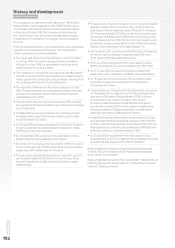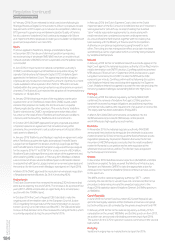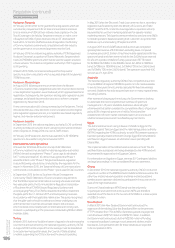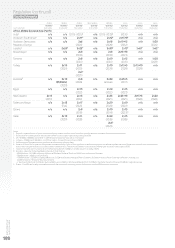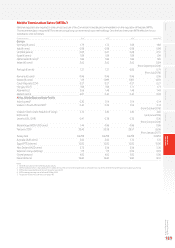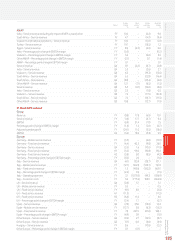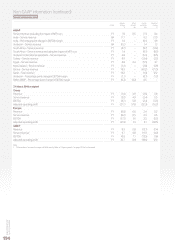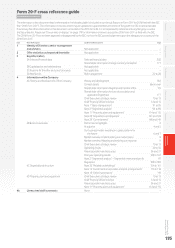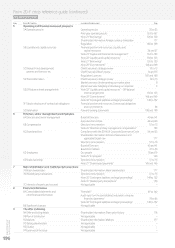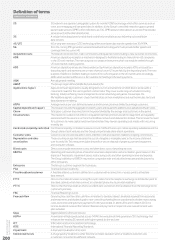Vodafone 2016 Annual Report Download - page 192
Download and view the complete annual report
Please find page 192 of the 2016 Vodafone annual report below. You can navigate through the pages in the report by either clicking on the pages listed below, or by using the keyword search tool below to find specific information within the annual report.
Vodafone Group Plc
Annual Report 2016
190
Non-GAAP information
Unaudited information
In the discussion of our reported nancial position, operating results and cash ows, information is presented to provide readers with additional
nancial information that is regularly reviewed by management. However, this additional information presented is not uniformly dened by all
companies, including those in the Group’s industry. Accordingly, it may not be comparable with similarly titled measures and disclosures by other
companies. Additionally, certain information presented is derived from amounts calculated in accordance with IFRS but is not itself an expressly
permitted GAAP measure. Such non-GAAP measures should not be viewed in isolation or as an alternative to the equivalent GAAP measure.
EBITDA
EBITDA is operating prot excluding share in results of associates, depreciation and amortisation, gains/losses on the disposal of xed assets,
impairment losses, restructuring costs, other operating income and expense and signicant items that are not considered by management
to be reective of the underlying performance of the Group. We use EBITDA, in conjunction with other GAAP and non-GAAP nancial measures
such as adjusted operating prot, operating prot and net prot, to assess our operating performance. We believe that EBITDA is an operating
performance measure, not a liquidity measure, as it includes non-cash changes in working capital and is reviewed by the Chief Executive to assess
internal performance in conjunction with EBITDA margin, which is an alternative sales margin gure. We believe it is both useful and necessary
to report EBITDA as a performance measure as it enhances the comparability of prot across segments.
Because EBITDA does not take into account certain items that affect operations and performance, EBITDA has inherent limitations as a performance
measure. To compensate for these limitations, we analyse EBITDA in conjunction with other GAAP and non-GAAP operating performance measures.
EBITDA should not be considered in isolation or as a substitute for a GAAP measure of operating performance. A reconciliation of EBITDA to the
closest equivalent GAAP measure, operating prot, is provided above and in note 2 “Segmental analysis” to the consolidated nancial statements.
Group adjusted operating prot and adjusted earnings per share
Group adjusted operating prot excludes non-operating income of associates, impairment losses, restructuring costs, amortisation of customer
bases and brand intangible assets, other operating income and expense and other signicant one-off items. Adjusted earnings per share also
excludes certain foreign exchange rate differences, together with related tax effects. We believe that it is both useful and necessary to report these
measures for the following reasons:
a these measures are used for internal performance reporting;
a these measures are used in setting director and management remuneration; and
a they are useful in connection with discussion with the investment analyst community and debt rating agencies.
A reconciliation of adjusted operating prot to the respective closest equivalent GAAP measure, operating prot, is provided above and in note 2
“Segmental analysis” to the consolidated nancial statements. A reconciliation of adjusted earnings per share to basic earnings per share is provided
in the “Operating results” on page 31.
Cash ow measures
In presenting and discussing our reported results, free cash ow and operating free cash ow are calculated and presented even though these
measures are not recognised within IFRS. We believe that it is both useful and necessary to communicate free cash ow to investors and other
interested parties, for the following reasons:
a free cash ow allows us and external parties to evaluate our liquidity and the cash generated by our operations. Free cash ow does not include
payments for licences and spectrum included within intangible assets, items determined independently of the ongoing business, such as the
level of dividends, and items which are deemed discretionary, such as cash ows relating to acquisitions and disposals or nancing activities.
Inaddition, it does not necessarily reect the amounts which we have an obligation to incur. However, it does reect the cash available for
such discretionary activities, to strengthen the consolidated statement of nancial position or to provide returns to shareholders in the form
of dividends or share purchases;
a free cash ow facilitates comparability of results with other companies, although our measure of free cash ow may not be directly comparable
tosimilarly titled measures used by other companies;
a these measures are used by management for planning, reporting and incentive purposes; and
a these measures are useful in connection with discussion with the investment analyst community and debt rating agencies.




